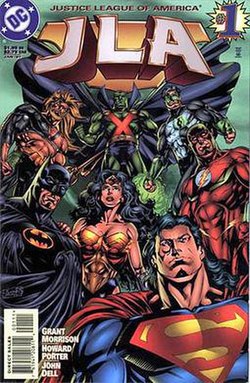Publication history
The low sales of the various Justice League spin-off books by the mid-1990s [2] prompted DC to revamp the League as a single team (all the various branch teams were disbanded) on a single title. A Justice League of America formed in the September 1996 limited series Justice League: A Midsummer's Nightmare by Mark Waid and Fabian Nicieza. In 1997, DC Comics launched a new Justice League series titled JLA, written by Grant Morrison with art by Howard Porter and inker John Dell. Morrison stayed as writer for the series through issue #41, though several issues had fill-in writers. JLA #18-#21 and #33 were written by Mark Waid. Mark Millar, Devin Grayson and Mark Waid, and J.M. DeMatteis wrote issues #27, 32 and 35, respectively.
This series, in an attempt at a "back-to-basics" approach, used as its core the team's original and most famous seven members (or their successors): Superman, Batman, Wonder Woman, Aquaman, the Flash (Wally West), Green Lantern (Kyle Rayner), and Martian Manhunter. [3] Additionally, the team received a new headquarters, the "Watchtower", based on the Moon. JLA quickly became DC's best-selling title, [4] a position it maintained on and off for several years. [5]
Morrison introduced the idea of the JLA allegorically representing a pantheon of gods, with their different powers and personalities, incorporating such characters as Zauriel, Big Barda, Orion, Huntress, Barbara Gordon (Oracle), Steel (John Henry Irons), and Plastic Man. They also had Aztek, Tomorrow Woman, and Green Arrow (Connor Hawke) as temporary members. [6]
Under Morrison, the series pitted the League against a variety of enemies including the White Martians, renegade angels, a new incarnation of the Injustice Gang led by Lex Luthor, and the Key. Other foes were the new villain Prometheus, the existing JLA villain Starro, "the Ultra-Marines", and a futuristic Darkseid. Morrison's run culminated in an arc titled "World War III", which involves the New Gods preparing the Earth for battle against a creature known as "Mageddon", a super-sentient weapon of mass destruction.
Since this new League included most of DC's most powerful heroes, the focus of the stories changed. The League now dealt only with Earth-shattering, highest-priority threats which could challenge their tremendous combined power. Enemies faced by this new JLA included an invading army of aliens, a malfunctioning war machine from the future, a horde of renegade angels, a newly reformed coalition of villains as a counter-league, mercenaries armed with individualized take-down strategies for each superhero, various cosmic threats, and the enraged spirit of the Earth itself. In addition, because almost all of the members had their own comics, the stories were almost always self-contained, with all chapters occurring within JLA itself and very rarely affecting events outside of that series. Developments from a hero's own title (such as the new costume and electric-based powers temporarily adopted by Superman in 1997–1998) were reflected in the League's comic book, however.
Morrison departed with issue #41, after which the book saw runs by Mark Waid and Joe Kelly. Subsequent to this, the series switched to a series of rotating writers with issue #91 while Kelly (via JLA #100) was given the miniseries Justice League Elite #1-12, which featured Green Arrow, the Flash, and several other characters. The new format saw stories by John Byrne, Chuck Austen, and Kurt Busiek. Geoff Johns and Allan Heinberg would take over the book with #115, which saw a multi-part storyline dealing with the aftermath of Identity Crisis , and served as a lead-in to the events of Infinite Crisis , as Superboy-Prime destroyed the Watchtower at the end of issue #119. Bob Harras wrote the book's final storyline (JLA #120–125) as Green Arrow struggled to keep the League afloat.
Storylines
Despite all of this, DC did not create continuing spin-off series as it had done before. Instead, a large number of miniseries and one-shots featuring the team were released. One spin-off team, the Justice League Elite was created following the events of JLA #100, but their miniseries was limited to 12 issues, and the team appeared only once after the miniseries ended its run. JLA's popularity was also able to launch the JSA series, which was relaunched as Justice Society of America to coincide with the new Justice League of America book.
In 2005, a story arc by Geoff Johns and Alan Heinberg called "Crisis of Conscience" (JLA #115–119) depicted the dissolution of the Justice League of America as the breakdown of trust shown in the 2004 limited series Identity Crisis reached its zenith. At the end of the arc, Superboy-Prime destroyed the Justice League Watchtower. JLA, one of several titles to be cancelled at the conclusion of the Infinite Crisis storyline, ended with issue #125.
As depicted in the Villains United: Infinite Crisis Special and the final issue of Infinite Crisis itself, preparations for the defense of Metropolis against an army of organized supervillains required a brief and temporary expansion of the Justice League to its largest roster to date. The main defensive teams of the JLA, JSA, Teen Titans, and Outsiders already being occupied elsewhere by the Crisis, it fell on Oracle and Martian Manhunter to contact and deputize seemingly every active or once active hero in the DC Universe as Justice League members, effective immediately, to form a last line of defense for the city.
